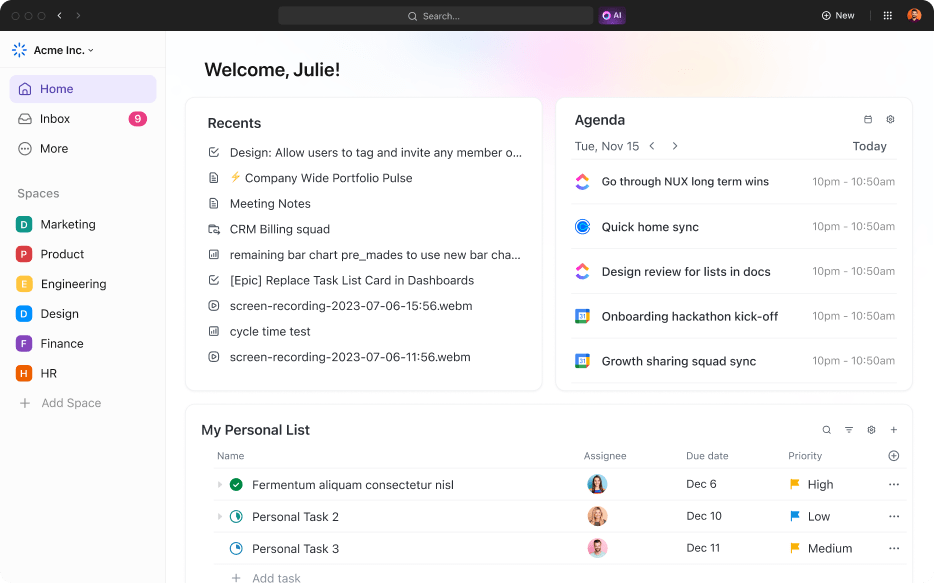

Taking the chaos of a new project and breaking down everything that needs to get done into individual tasks only moves things from chaos to organized chaos. On the other hand, understanding how all the information and people are connected and how data moves through a project is called workflow management.
And workflow management can banish chaos from your projects and bring order. ?
The best way to help you and your team streamline your processes is through workflow management software. These tools do more than capture tasks and make schedules. They aid you in understanding how to do each step, assigning responsibilities, tracking progress, and, most importantly, automating manual workflow steps.
The benefits of implementing good workflow software are significant, and that’s why there are a lot of choices out there. But don’t worry—we won’t let you get lost in the workflow woods! We’ve created a list of 15 different workflow management software solutions.
And for each workflow management tool, we’ve included a brief introduction, the strengths and weaknesses, the cost, and ratings by actual users.
What Should You Look for in Workflow Software?
If you’re new to the concept, the most important thing you should know is that workflow management is a way to optimize processes and task execution while focusing on goals. This is done by looking at how the work flows through a project—hence the term “workflow.”
Effective leaders implement workflow management software into their business processes because it boosts the efficiency of teams while improving the final product.
Once you know what workflow management is and how it can help your team, it’s time to look at what makes this style of project management software so effective. The best workflow software depends on your team’s needs, like automation, collaboration, and project management. Here are a few features to consider when you’re looking:
- Workflow management features to visually map and modify your business processes
- Key features to define and track due dates with simple drag-and-drop features to quickly move and schedule tasks
- Metrics that allow you to track project progress and manage the performance of individuals and the team as a whole
- The ability to automate routine tasks to cut down the manual processes (AKA: workflow automation)
- Integration with your other tools
- Team collaboration capabilities that include all stakeholders and team members in one space
- Customizable templates to help you create custom dashboards, track progress, and automate workflows
- Task management features with versatile project dependency mapping
As always, your specific needs depend on what your project goals are and what project management methodologies you leverage. Make sure you don’t pick a tool because of one bright and shiny part, pick a solution that delivers on all of your needs. ?
The 15 Best Workflow Program Software Systems
There’s a lot out there to choose from. Many of these tools focus on one aspect of workflow management, like diagramming, software development, or automation of repeatable tasks. As you review each of them, keep your overall goals in mind and consider what will best help your team be collaborative and efficient.
1. ClickUp – Best for project management
Built from the ground up to excel at encouraging team productivity and collaboration, ClickUp has business workflow management threaded into every feature and capability. More than a workflow management tool, it’s a productivity hub that combines features usually only available as separate tools in a single, easy-to-use interface.
With ClickUp, there’s always more than one way to herd your cats. The workflow management platform integrates communication with documentation, planning with tracking, and even brings the latest AI text-generation tools into the environment.
The three things project managers value most in ClickUp are the customizable templates, ClickUp Mind Maps, and ClickUp Automations, to limit repetitive tasks. These features and many others let you and your team focus on getting work done with consistency and efficiency.
ClickUp best features:
- ClickUp Brain to automate repetitive tasks with AI
- Wide range of task automation tools that are easy to set up and monitor
- Multiple ways to create and manage tasks, including subtasks and checklists
- Consistent, friendly-looking user interface that’s great for newbies as well as power users
- Multiple visualization tools, including Gantt charts, Mind Maps, PertCharts, and many more
- Custom status feature allows users to create their own list of standard status values
- Great collaboration tools like the ability to leave comments on task assignments
- Integration with other popular productivity tools such as Slack, Zoom, GitHub, and more
- Large library of workflow templates to build your own custom workflows. Try ClickUp’s Work Plan Whiteboard Template to plan your next project.
ClickUp limitations:
- There’s so much capability, it takes a little time to learn your way around
- Some of the new capabilities are not fully developed yet.
ClickUp pricing:
- Free Forever
- Unlimited: $7/month per user
- Business: $12/month per user
- Enterprise: Contact for pricing
- ClickUp Brain is available on all paid plans for $7 per Workspace member per month
ClickUp ratings and reviews:
- G2: 4.7/5 (6,900+ reviews)
- Capterra: 4.7/5 (3,600+ reviews)
2. ProWorkflow – Good for small to mid-sized teams

Originally developed as a downloadable workflow management tool, ProWorkflow is now a SaaS-based toolset with an international audience. It focuses on project, task, and time tracking, with growing capabilities for the management of contacts, workflow, and resources.
The tool is primarily designed for businesses with small to mid-sized teams. ProWorkflow has a strong mobile app, making it easy to use on the road as well.
ProWorkflow best features:
- All-in-one dashboard to see all ongoing projects with drag-and-drop features
- Accurate and easy-to-implement time management tools
- Microsoft Teams and Outlook integration
- Mobile Apps for iOS and Android
- Business management tools like quoting and invoicing
- Growing number of templates
ProWorkflow limitations:
- Designed for startups, freelancers, and small businesses but not for larger teams or companies
- Limited workflow automation key features
- Does not integrate with many common productivity tools
- Missing many common tools for project and workflow management like Gantt charts, Kanban boards, and mind-mapping
- Navigating the user interface can be confusing
- A more expensive version is needed for field and form customization and templates
- No free version
ProWorkflow pricing:
- Professional: $20/month per user
- Advanced: $30/month per user
ProWorkflow ratings and reviews:
- G2: 4.1/5 (35+ reviews)
- Capterra: 4.5/5 240+ reviews)
3. Flokzu – Good for process automation
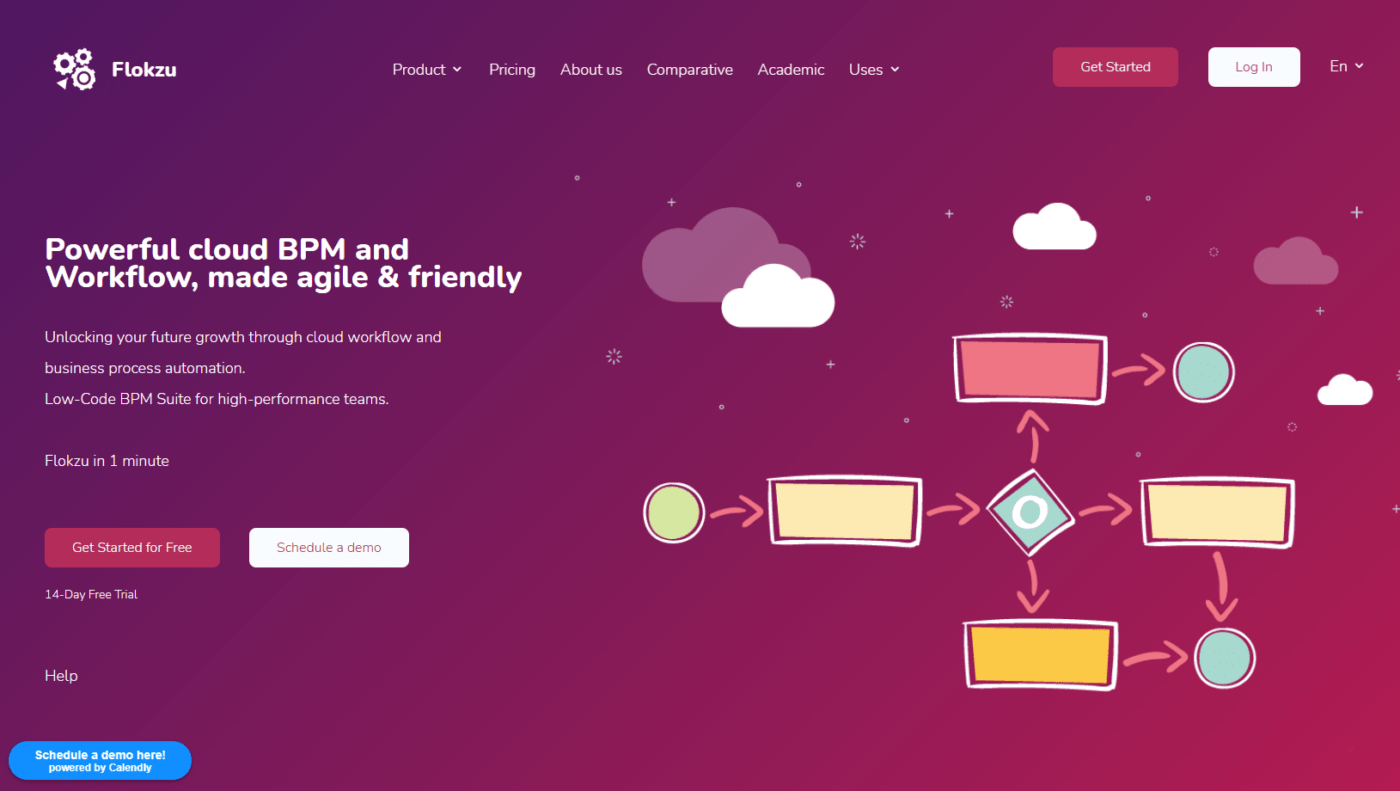
Flokzu presents itself as workflow software that provides process automation and deployment. It’s designed for users who don’t have an IT background but who want to automate their business processes and operations while connecting the flow of information from one cloud-based application to another.
This workflow management software provides a no-code drag-and-drop interface. This way, you can easily model your processes and integrate them with other popular productivity tools. Flokzu also offers a process template library. The templates are customizable, and you can edit them to meet your specific needs.
Flokzu best features:
- Focused on business processes—and does that very well
- Integration with most online tools through Zapier and web services
- Sandbox version to try your custom workflows out without touching live data
- Powerful report-generation tool for presenting the data gathered with automation
- Built-in database functionality
Flokzu limitations:
- Doesn’t have workflow definition, assignment, or monitoring capabilities—it only does automation
- Missing project and workflow management tools
- Missing team collaboration and communication tools
- Database tools are limited
- Connecting application program interfaces (APIs) can be difficult for novices
Flokzu pricing:
- Free: 14-day trial
- Standard: $15/month per user
- Premium: $21/month per user
- Enterprise: Contact for pricing
Flokzu ratings and reviews:
- G2: 4.9/5 (25+ reviews)
- Capterra: 4.8/5 (70+ reviews)
4. Backlog – Good for bug tracking

Backlog is project management software with code management and bug-tracking built in. The platform provides a single location for a company to keep all of its projects, tasks, and files. It integrates with other tools from Nulab, which is the company that develops, sells, and supports Backlog.
Backlog is all about getting the team on the same page. This means you can collaborate with team members, whether they are in-house or remote. Its primary focus is to provide transparency and control over projects, tasks, bugs, and requests.
Backlog best features:
- Comprehensive collaboration key features for DevOps teams and others in the organization
- Good bug-reporting and bug-tracking tool
- Simple interface designed for software projects
- Dashboards are a useful tool for project managers
- Useful Slack and email integration
- Supports documentation in parallel with development teams
Backlog limitations:
- Lacks capabilities for projects outside of software development
- Integration with other productivity tools is limited
- Gantt charts don’t include dependencies
- The use of subtasks is limited
- No workflow automation to handle routine tasks
Backlog pricing:
- Free: 10 named users, 1 active project
- Starter: $35/month, 30 named users, 5 active projects
- Standard: $100/month, unlimited users, 100 active projects
- Premium: $175/month, unlimited users and projects
- Enterprise: Contact for pricing
Backlog ratings and reviews:
- G2: 4.5/5 (160+ reviews)
- Capterra: 4.5/5 (80+ reviews)
5. Lucidchart – Good for intelligent diagramming

Lucidchart provides a diagramming platform that can be used to visually show project workflows. This workflow management solution is a collaborative, web-based tool that allows users to draw representations of people, processes, and systems within a business or team.
It’s meant to be used with a workflow management system as a way to create graphical visualizations of workflows. It’s a great tool for team members to see the big picture of their tasks and workflows.
Lucidchart best features:
- Interactive diagramming of workflow processes and visualization of data in a single, collaborative platform to avoid context switching
- Cloud-based, so everyone on the team can access it no matter where they work from
- Chat in the edit window and real-time co-authoring
- Easy to use yet powerful; even new users can create complex diagrams
- Integrates with common collaboration and process documentation tools
Lucidchart limitations:
- Only does diagram creation
- No real tools to manage projects
- No workflow automation capability for repetitive tasks
- Large complex diagrams can bog down the system
- No templates for a few common industries like education and healthcare
Lucidchart pricing:
- Free: up to 3 documents
- Individual: $7.95/month per user
- Team: $9.00/month per user
- Enterprise: Contact for pricing
Lucidchart ratings and reviews:
- G2: 4.6/5 (2,300+ reviews)
- Capterra: 4.5/5 (1,900+ reviews)
Check out these Lucidchart alternatives!
6. Nintex – Good for identifying bottlenecks

Nintex is workflow management software providing task management and process automation. It sets itself apart by including tools to identify your processes and bottlenecks for further optimization or automation, as well as delivering tools to capture, map, and manage the processes your organization uses. It’s designed for business processes like employee onboarding and data exchange but can be used on creative projects.
Nintex’s platform excels in simplifying complex processes through its user-friendly interface, allowing teams to automate workflows with little to no coding experience required. It empowers users to create, manage, and optimize process automation apps across various departments including HR, operations, and customer service, streamlining mundane tasks and freeing up valuable time.
Nintex best features:
- Large library of workflow templates
- Includes some document management tools, including interactive approvals and digital signatures
- Both cloud-based automation for connecting data and repetitive task automation
- Workflow analytics capabilities to assess how well automation is going
- Documentation tools at every step
Nintex limitations:
- Focused only on process automation and only contains a few features found in fully functional workflow software
- No project management or collaboration tools
- Complex workflows are difficult to diagram and automate
- No sandbox capability
- Each capability is licensed separately and charged separately
- Pricing is for larger companies
Nintex pricing:
- Pro: $15,000 to $35,000/year per module
- Premium: $30,000 to $60,000/year per module
- Custom: Contact for pricing
Nintex ratings and reviews:
- G2: 4.2/5 (690+ reviews)
- Capterra: 4.5/5 (1,900+ reviews)
7. Kissflow – Good for customizing process workflows
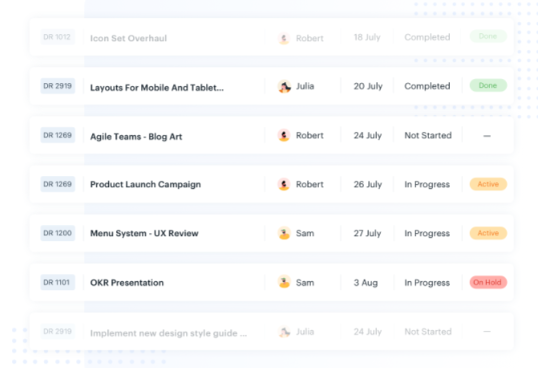
Kissflow is a low-code/no-code development platform aimed at business process management. It can be used to create business applications and automate tasks. They refer to their software as a work platform because it not only includes the development tools, it has boards for project visualization and tracking, collaboration tools, and analytics.
Kissflow distinguishes itself in the crowded workflow management and automation space with its intuitive design and focus on enhancing the efficiency of business processes. Its strength lies in its versatility, catering to a wide range of functions from project management to process automation, all under a single, user-friendly interface. This platform is particularly beneficial for organizations looking to streamline their operations without investing heavily in IT infrastructure or specialized personnel. By offering a suite of tools designed for collaboration, tracking, and analytics, Kissflow enables teams to maintain clarity on project progress and identify areas for improvement, fostering a culture of continuous optimization and innovation.
Kissflow best features:
- A user-friendly interface oriented towards business users, not IT or software professionals
- Ability to create custom workflows for your unique needs
- Mobile app for iOS and Android
- Analytics and reporting built in to measure process performance
- Comprehensive document management system
- Low-code allows for some programming when needed
Kissflow limitations:
- The project management and collaboration tools are simplistic
- Integration with other platforms is limited
- Formulas and complex logic for fields is limited
- No way to update users on changes made by other users
- Complex workflow automation is difficult to implement
Kissflow pricing:
- Small business: $15/month per user
- Corporate: $20/month per user
- Enterprise: Contact for pricing
Kissflow ratings and reviews:
- G2: 4.2/5 (520+ reviews)
- Capterra: 3.9/5 (35+ reviews)
Check out these Kissflow alternatives!
8. HighGear – Good for no-code solutions
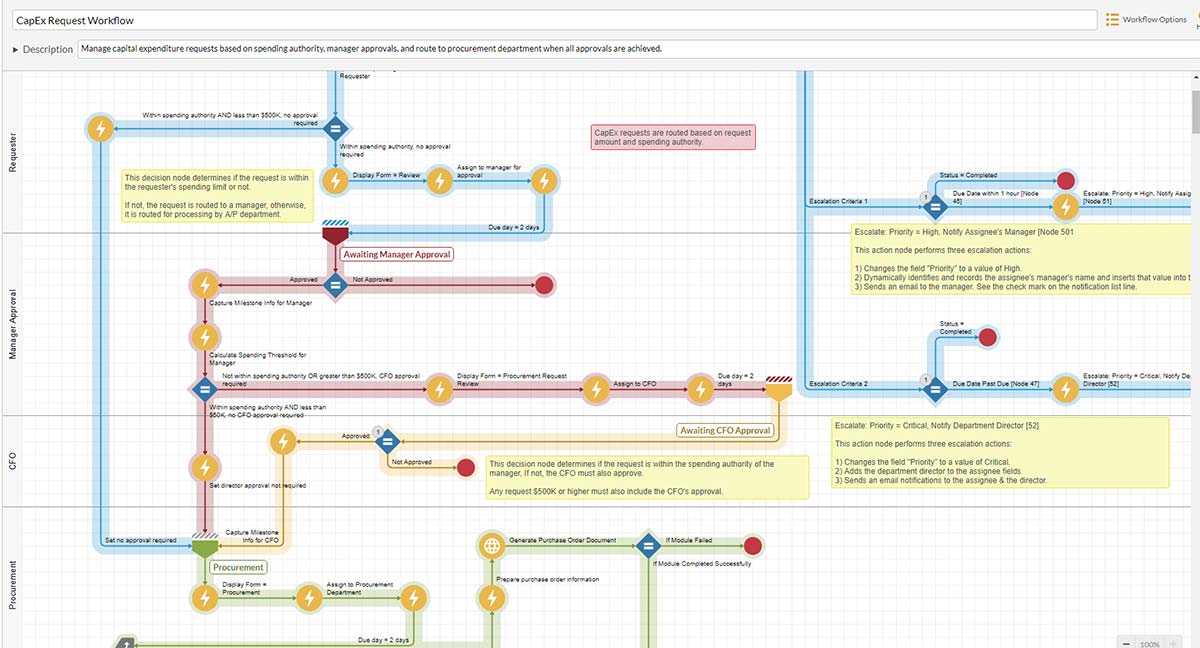
HighGear is a no-code workflow automation software platform that provides enterprise workflow management at scale in a system designed for everyday business users. It’s a flexible, fast, and powerful toolset that delivers automation of simple and complex business processes. Besides workflow automation, it includes tools for task management, digital asset management, and reporting.
HighGear distinguishes itself in the enterprise-level workflow management space with its no-code design, delivering a comprehensive set of tools for automating business processes to non-technical users. The platform’s user-friendly interface and extensive feature list make it an ideal choice for organizations looking to automate end-to-end workflows without depending on expensive IT resources or requiring specialized knowledge.
HighGear best features:
- A no-code process automation tool designed for managers, technical creatives, and business analysts to build, manage, and deploy enterprise-grade workflow applications
- No-code development environment makes creating applications fast
- Doesn’t sacrifice power to deliver ease of use
- Enterprise-grade security
HighGear limitations:
- Focused on process automation—and missing tools for project management and workflow optimization
- Collaboration and task management is limited
- Because it supports enterprise-level process automation, it can be overwhelming at times
- Pricing can be expensive for smaller companies
HighGear pricing:
- Team: Contact for pricing
- Department: Contact for pricing
- Business: Contact for pricing
- Global: Contact for pricing
HighGear ratings and reviews:
- G2: N/A
- Capterra: 5.0/5 (20+ reviews)
9. Workato – Good for enterprise teams

Workato is an enterprise-level business process automation platform that provides a no-code interface for creating what they call “recipes” to automate business workflows. Users can define what user activity or data changes trigger an action, and then what recipe to run in response.
Workato’s strength lies in its powerful recipe creation interface designed for technical and non-technical users alike, allowing them to quickly create complex workflows that would otherwise require specialized knowledge or expertise. Additionally, Workato’s extensive integration capabilities make it an ideal tool for businesses looking to streamline their operations and establish a cohesive work environment by consolidating various platforms and services into one system.
Workato best features:
- Integration with most business software and data tools
- Enterprise-level security and governance
- User-friendly and intuitive interface
- Flexibility in how you can construct the automation of a workflow
Workato limitations:
- Powerful capabilities but also a steep learning curve
- No planning, collaboration, or project management tools
- Per-task pricing is not clear
- Debugging a recipe can be difficult
- Limited debugging tools
Workato pricing:
- Contact for pricing
Workato ratings and reviews:
- G2: 4.7/5 (320+ reviews)
- Capterra: 4.7/5 (45+ reviews)
10. Cflow – Good for converting spreadsheets into workflows
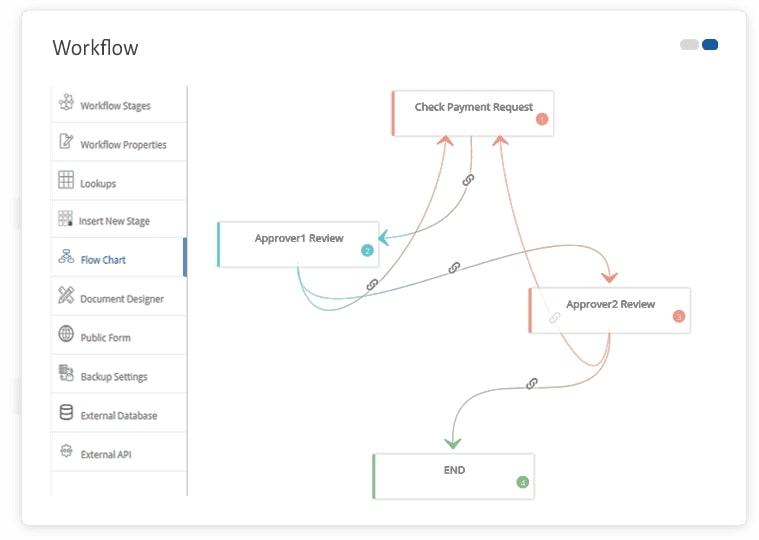
Cflow is a no-code platform designed to take your current business processes that use email and spreadsheets and convert them into automated workflows. It’s designed to scale as a business grows, delivering digital transformation for now and into the future.
It’s a drag-and-drop interface that allows you to easily create workflows and includes mobile support.
Cflow distinguishes itself from other workflow automation tools with its focus on streamlining business processes through the elimination of paper-based data management, leveraging modern technology to digitize operations. With features like document generation, dynamic task management, and detailed reporting, Cflow enables organizations to optimize their workflows and establish a comprehensive paperless environment, reducing errors and processing times for increased productivity.
Cflow best features:
- Sophisticated rules engine allows for easy setup of complex workflows
- Drag-and-drop form builder to easily capture user input for any workflow
- Easily add routing and notifications to workflows so everyone impacted is kept up to date
- Most aspects of any workflow can be customized to meet specific needs
- Reports and analytics provide consistent and constant feedback on how automated workflows are running
- Best-in-class security and encryption to protect user data
Cflow limitations:
- Focused on business workflows and not project workflow automation
- Limited project management and collaboration tools
- Workflows can run slowly when dealing with a large amount of data
- Extensive capabilities make learning the interface daunting at first
- Existing template library only includes business process automation
- Troubleshooting complex workflows can be challenging
Cflow pricing:
- Free: 14-day trial
- Happy: $12/month per user
- Joy: $16/month per user
- Bliss: $22/month per user
Cflow ratings and reviews:
- G2: 5/5 (50+ reviews)
- Capterra: 4.9./5 (20+ reviews)
11. Pipedrive – Good for automating sales workflows

A customer relationship management (CRM) software system, Pipedrive manages and automates your sales workflow. It delivers the CRM features you expect, along with building sales workflows and automating repetitive administrative tasks. It’s designed to help sales teams of all sizes control complex sales processes. Pipedrive also offers an activity-based sales approach to take your salespeople through the workflow process of finding, nurturing, and closing sales.
Pipedrive’s strength lies in its focus on automating the sales process, allowing businesses to concentrate on closing deals rather than spending time on administrative tasks. With features like email integration, lead scoring, and activity reminders, Pipedrive enables organizations to streamline their sales workflows and manage customer relationships effectively.
Pipedrive best features:
- A virtual sales assistant suggests personalized tips and ideas for improved performance as you work
- Automate repetitive tasks for sales
- Open API to connect to other tools
- Users can set up simple conditional logic and actions to move sales through the process automatically
- Great integration with shared calendars and email
Pipedrive limitations:
- Not a full workflow management tool; Pipedrive just does sales process management
- Lacks workflow visualization tools
- Data entry can become repetitive
- Report customization is limited
- Workflow automation is not as capable as other CRM systems
Pipedrive pricing:
- Free: 14-day trial
- Essential: $21.90/month per user
- Advanced: $37.90/month per user
- Professional: $59.90/month per user
- Power: $74.90/month per user
- Enterprise: $119/month per user
Pipedrive ratings and reviews:
- G2: 4.2/5 (1,600+ reviews)
- Capterra: 4.5/5 (2,800+ reviews)
12. Process Street – Good for tracking workflow processes
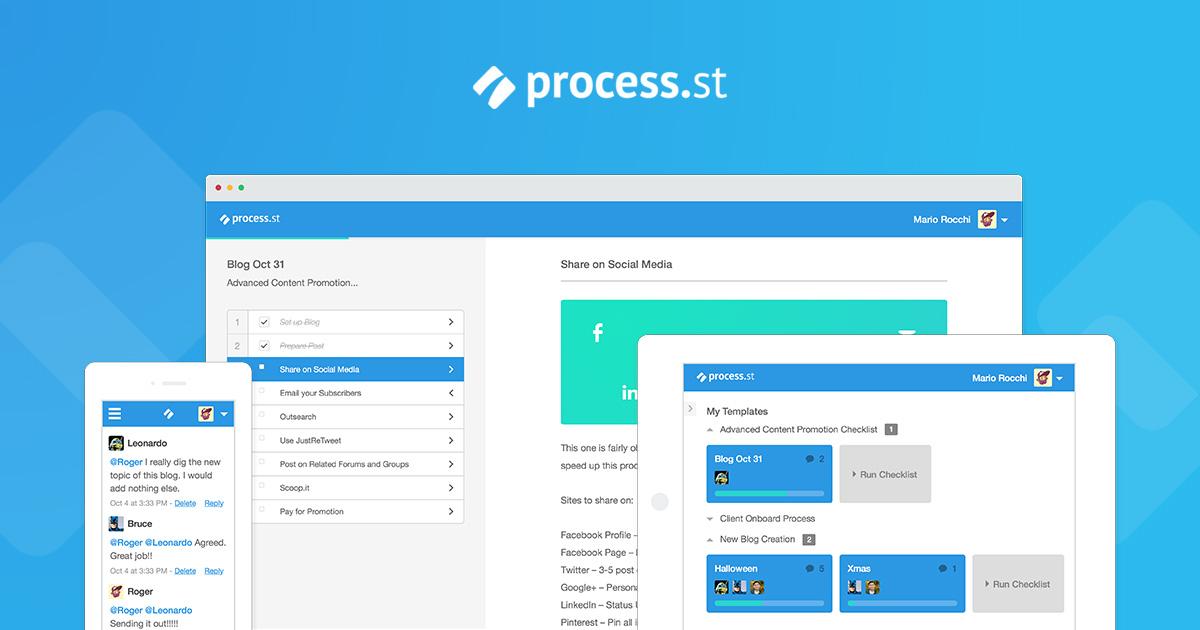
Process Street is another business process automation (BPA) tool that lets users create automated workflows without writing any software. It allows users without any IT expertise to create workflows, run multiple instances of each workflow, and track progress and share the results with others. It offers a simple no-code interface built for a team environment where users can collaborate while creating and running workflows.
Process Street stands out for its ability to streamline repetitive processes and standardize task completion, making it ideal for organizations looking to automate their workflows. With features like form fields, conditional logic, and integrations with other popular software platforms, Process Street enables teams to work more efficiently and effectively by reducing errors and delays.
Process Street best features:
- Designed to be more collaborative than most BPA tools, it supports teamwork with activity feeds to share who did what
- Setup of user groups to manage permissions and access control more easily
- Look and feel of workflows is attractive and efficient with rich media like audio and video
- Comprehensive integration with other apps
- Powerful and intuitive form-building tools
- Extensive template library that includes business, HR, and marketing tasks
Process Street limitations:
- Not a full workflow management software system, it lacks many project management and workflow-builder tools
- Some of the more advanced workflows require third-party applications
- Workspace and process control can be overwhelming
- Process workflow setup can be confusing for new users
Process Street pricing:
- Free: 14-day trial
- Startup: $100/month, limited to5 users
- Pro: $415/month
- Enterprise: $1,660/month
Process Street ratings and reviews:
- G2 4.6/5 (350+ reviews)
- Capterra: 4.5/5 (2,800+ reviews)
13. Integrify – Good for users without programming knowledge
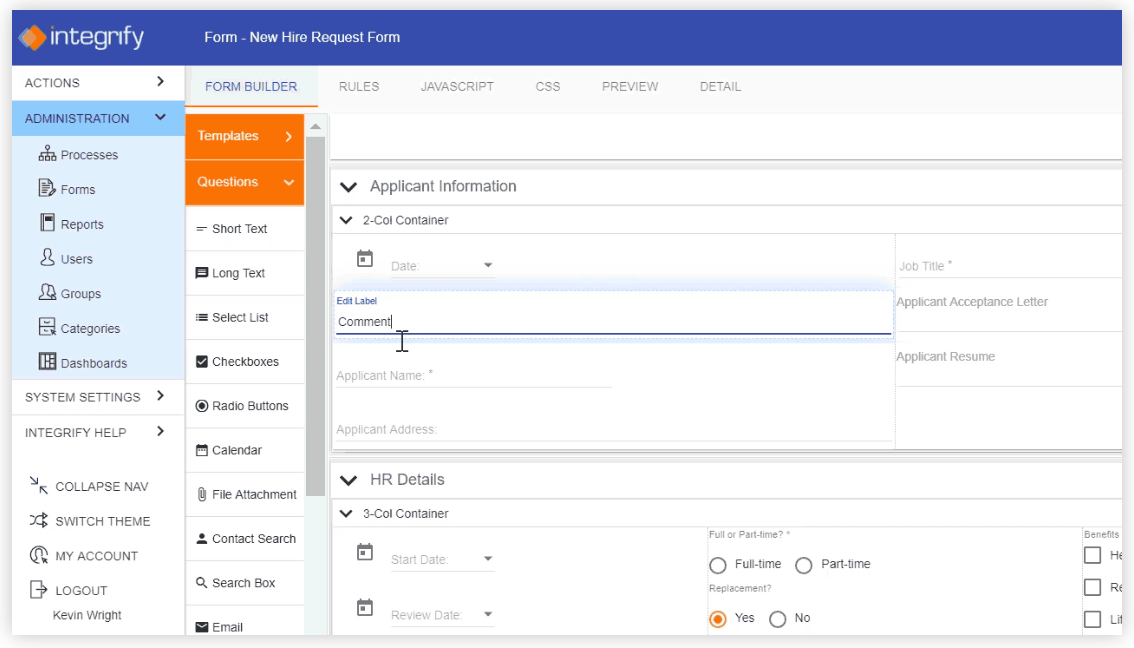
Integrify quickly automates any business process without code. It provides users with a process builder, form designer, service portal, and reporting capabilities in a single, consistent user interface. It also integrates with the most common business productivity tools.
Integrify provides users with an intuitive drag-and-drop interface that allows them to easily create custom workflows without needing any programming knowledge.
Integrify stands out for its extensive customization options, providing organizations with the flexibility to design and implement workflows tailored to their specific business needs.
Integrify best features:
- User-friendly interface makes process automation simple and intuitive
- Powerful no-code tools make process automation easy for new users
- Includes a self-service user support module
- Comprehensive reporting
- Powerful report customization
Integrify limitations:
- Not a full workflow management system, it lacks many project management and workflow-builder tools
- Styling of forms is limited
- Notifications are difficult to set up and lack copy and reuse capabilities
- No templates
- Requires redundant entry of information on more complex workflows
- The number of features and options can be overwhelming
Integrify pricing:
- All versions: Contact for pricing
Integrify ratings and reviews:
- G2: 4.4/5 (30+ reviews)
- Capterra: 4.5/5 (20+ reviews)
14. ProcessMaker – Good for sophisticated users
As the name implies, ProcessMaker helps users make process automation tools. It’s a low-code solution that uses a visual interface for most steps but allows more sophisticated users the ability to add a few lines of software when needed.
It offers users an intuitive and user-friendly workflow builder that enables them to create automated workflows without requiring extensive knowledge of programming languages, making it ideal for businesses looking to automate their processes quickly.
ProcessMaker distinguishes itself with its powerful form building tools, allowing users to design customized forms using a drag-and-drop interface. Features like real-time analytics and reporting, integration capabilities, and advanced form designing make ProcessMaker an excellent option for organizations looking to streamline their processes and improve productivity.
ProcessMaker best features:
- Comprehensive visual tool for modeling processes
- Unique capability to get feedback from users via email with integrated forms
- Powerful monitoring of business activity with notifications
- Supports embedding automation into your own applications
- Document scanning and storage tool
ProcessMaker limitations:
- Not a complete workflow software or workflow automation tool, it lacks many project management and process visualization tools
- Search could be improved
- Form customization is limited
- Requires a bit of expertise for coding because it’s low-code, not no-code
ProcessMaker pricing:
- Low-code platform, Standard: $1,495/month plus per-user fees
- Low-code platform, Enterprise: $2,479/month plus per-user fees
- Other modules and packages: Contact for pricing
ProcessMaker ratings and reviews:
- G2: 4.3/5 (270+ reviews)
- Capterra: 4.5/5 (175+ reviews)
15. Camunda – Good for process orchestration
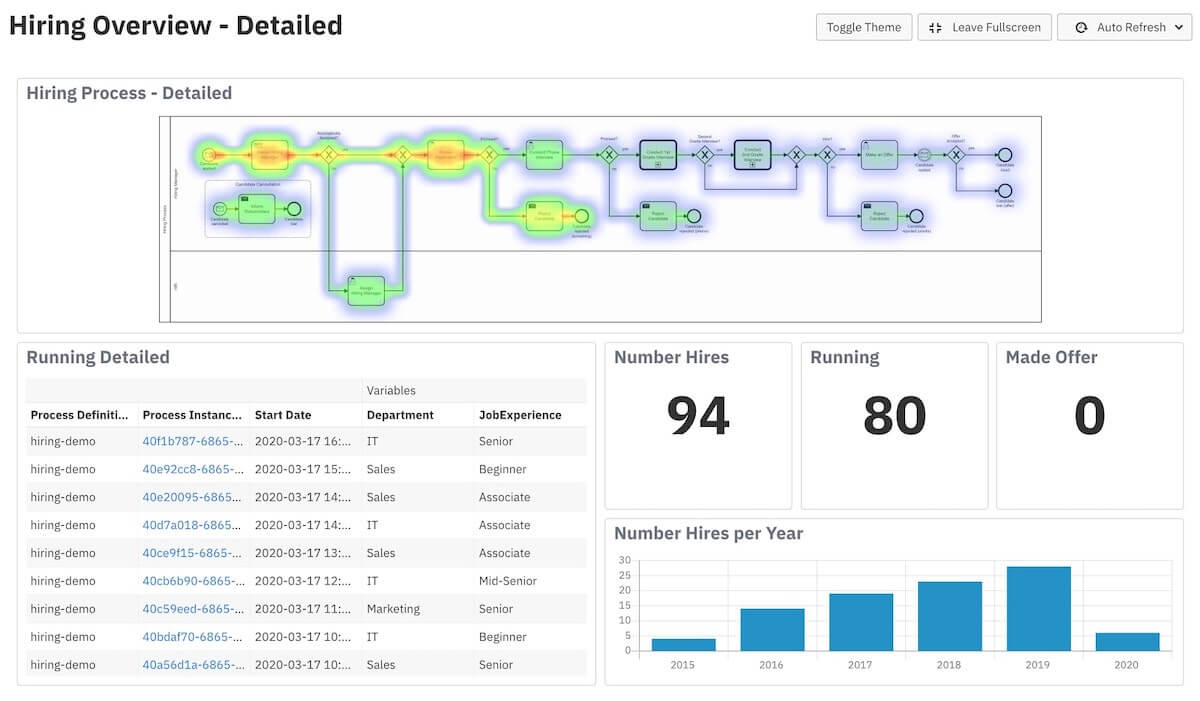
Camunda refers to itself as doing “process orchestration.” They provide tools to orchestrate complex process flows across devices, systems, and people. It’s designed by developers for developers and is not oriented toward business users.
Despite the learning curve, Camunda offers users an advanced workflow automation platform that is incredibly flexible and powerful.
Camunda stands out with its ability to automate complex workflows that involve multiple systems and parties, making it ideal for enterprises looking to streamline their processes across various departments and teams. With features like process modeling, form designing, and task management, Camunda enables organizations to improve their operations and achieve better efficiency.
Camunda best features:
- Uses common programming languages, including Java, Node.js, Python, and C#, to create automation
- Extensive developer documentation
- Comprehensive monitoring and reporting
- Low overhead creates fast automations that scale easily
Camunda limitations:
- Not a complete workflow software or workflow automation tool, it lacks many project management and process visualization tools
- No graphical tools or ability to see your workflows
- The user interface is limited
- A complex tool that isn’t easy for business users to understand or use
Camunda pricing:
- Free: up to five users
- Professional: $49/month for 10 users
- Enterprise: Contact for pricing
Camunda ratings and reviews:
- G2: 4.4/5 (75+ reviews)
- Capterra: 4.6/5 (10+ reviews)
Benefits of Using a Workflow Management Tool
As seen from the descriptions of these top workflow management systems, they offer a wide range of features and capabilities that can improve efficiency, streamline processes, and increase productivity for businesses. Some benefits of using a workflow management tool include:
- Streamlined Processes: With automated workflows, tasks are completed more quickly and accurately, reducing errors and delays.
- Centralized Data: Workflow management tools create a centralized location for all data, making it easier to access and track information.
- Improved Collaboration: Workflow management systems allow teams to collaborate more effectively by providing a platform where they can work on tasks together and receive updates in real-time.
- Increased Productivity: By automating repetitive and time-consuming tasks, employees have more time to focus on other important tasks, leading to increased productivity.
- Enhanced Visibility: Workflow management tools provide real-time visibility into the progress of tasks and processes, allowing managers to identify areas for improvement and make changes as needed.
- Scalability: As businesses grow, workflow management systems can easily scale to accommodate the increase in workload and users without compromising efficiency.
Optimize Your Project Management Workflow System
Understanding and optimizing your company’s workflows is no simple task. It’s tedious to constantly be monitoring your people and processes using emails, spreadsheets, and different programs. It’s time to get your head around your workflows and improve them. But as you can see, most business process automation software doesn’t really address activities beyond moving data from one program to another.
That’s why so many teams count on ClickUp as their preferred workflow management software. We deliver workflow management, including powerful automation tools, inside a comprehensive collaboration and project management tool.
For the best way to get a feel for why ClickUp is the productivity hub you need, sign up for a free trial, and start doing workflow management right. ✔️




